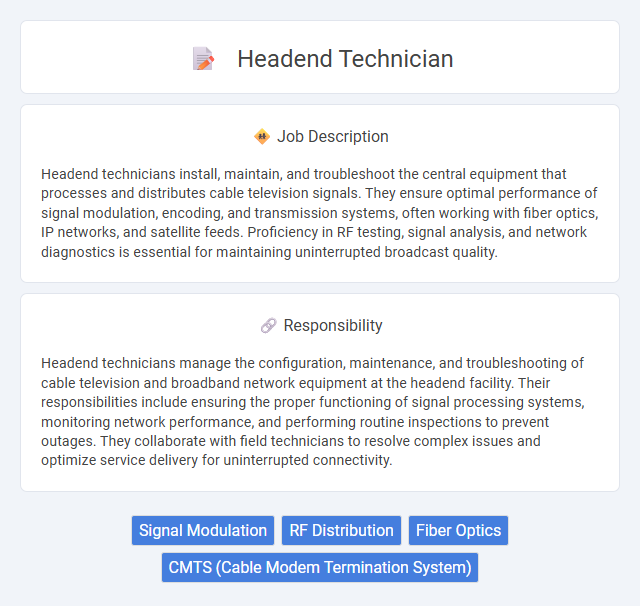
Headend technicians install, maintain, and troubleshoot the central equipment that processes and distributes cable television signals. They ensure optimal performance of signal modulation, encoding, and transmission systems, often working with fiber optics, IP networks, and satellite feeds. Proficiency in RF testing, signal analysis, and network diagnostics is essential for maintaining uninterrupted broadcast quality.
People who enjoy problem-solving and working with complex technical systems might find the headend technician role suitable. Those comfortable with hands-on troubleshooting and adapting to evolving cable and satellite technologies could probably thrive in this position. Individuals who prefer routine tasks and limited physical activity may not find this job as fitting.
Qualification
Headend technicians require strong technical skills in fiber optics, satellite systems, and IP networks to efficiently manage signal distribution in cable networks. Certifications like SCTE Broadband Premises Installer (BPI) and experience with RF equipment enhance job performance and employability. Proficiency in troubleshooting, system installation, and adherence to safety standards are essential qualifications for this role.
Responsibility
Headend technicians manage the configuration, maintenance, and troubleshooting of cable television and broadband network equipment at the headend facility. Their responsibilities include ensuring the proper functioning of signal processing systems, monitoring network performance, and performing routine inspections to prevent outages. They collaborate with field technicians to resolve complex issues and optimize service delivery for uninterrupted connectivity.
Benefit
Headend technicians likely enjoy benefits such as competitive salaries and comprehensive health insurance packages. Opportunities for professional growth and skill development tend to contribute positively to job satisfaction. Access to modern technology and hands-on experience may enhance career advancement prospects in the telecommunications industry.
Challenge
A Headend technician role may involve handling complex signal processing and troubleshooting issues in high-pressure environments, which can present significant challenges. The probability of encountering unexpected technical faults or system failures requires strong problem-solving skills and quick decision-making. Managing multiple equipment types and coordinating with different teams might further increase the complexity of daily tasks.
Career Advancement
Headend technicians play a crucial role in maintaining and troubleshooting signal processing equipment for cable and telecommunications companies, offering a solid foundation in broadcast technology. Career advancement opportunities include specializing in network engineering, systems design, or progressing to supervisory and management roles within the telecommunications infrastructure sector. Continuous training in emerging technologies such as fiber optics, digital video processing, and IP networking enhances promotion potential and salary growth.
Key Terms
Signal Modulation
Headend technicians specialize in signal modulation techniques to optimize the transmission and reception of cable and satellite signals. They configure, test, and maintain modulators ensuring signal quality and minimizing interference within the headend facility. Proficiency in QAM, QPSK, and OFDM modulation standards is essential for effective signal processing and network reliability.
RF Distribution
Headend technicians specializing in RF distribution design, install, and maintain the signal processing equipment that ensures high-quality broadcast transmission from the source to the distribution network. They calibrate modulators, amplifiers, and filters to optimize signal strength and minimize interference across cable and satellite systems. Proficiency in handling spectrum analyzers and troubleshooting RF loss issues is essential for maintaining seamless headend operations and signal integrity.
Fiber Optics
Headend technicians specializing in fiber optics install, maintain, and troubleshoot fiber optic networks that connect multiple subscriber lines to a central distribution point, ensuring high-speed data transmission and signal integrity. Their expertise includes splicing fiber cables, testing signal quality with optical time-domain reflectometers (OTDR), and configuring headend equipment to support broadband services like internet, TV, and VoIP. Proficiency in fiber optic connectors, attenuation measurement, and adhering to industry standards such as IEEE 802.3 is critical for optimizing network performance and minimizing downtime.
CMTS (Cable Modem Termination System)
Headend technicians specialize in maintaining and troubleshooting CMTS (Cable Modem Termination System) equipment, which is critical for managing high-speed internet data traffic in cable networks. They configure and optimize CMTS to ensure efficient data transmission and minimal network latency, supporting thousands of simultaneous cable modem connections. Proficiency in monitoring signal quality, firmware upgrades, and network security measures on CMTS enhances overall broadband service reliability and performance.
 kuljobs.com
kuljobs.com